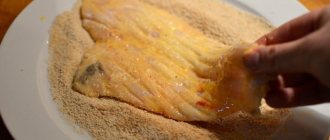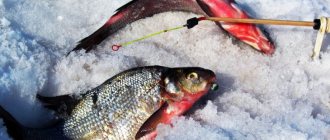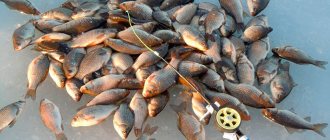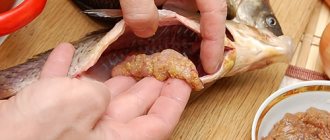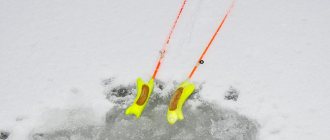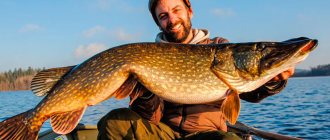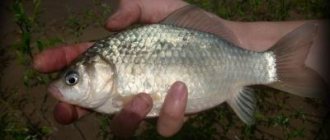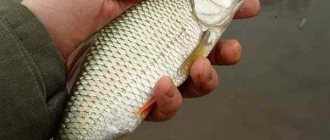Bream is a cunning and rather cautious opponent; luring it out of its usual habitat is not an easy task. Despite all the difficulties of bream fishing, the activity brings a lot of vivid impressions and an indescribable feeling of delight when the desired object of fishing is in your hands.
In many ways, the success of this event depends on the intelligence and dexterity of the fisherman himself, but here it is necessary to know promising places for fishing this fish, and the peculiarities of its behavior depending on the season, and the most favorable time of day, and, of course, to choose the right tackle .
Best time to hunt bream:
- Immediately after the mating season , which begins at the end of April, its duration is no more than 2 weeks. This is the time of active biting, the chebak shows an increased interest in food and hunts around the clock. The summer zhor ends in June, after which there is a decline.
- In mid-August, the fish begin to bite again, with a particularly good catch noted at dawn and sunset.
The most favorable weather for catching chebak is calm, windless weather.
The intensity of the bite continues until mid-November.
As soon as the first frosts hit, the bream falls into winter torpor. Fishing in winter is also quite a productive activity; you can go hunting already on the first ice.
Equipment of a float rod for bream
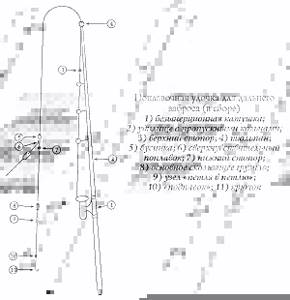
The use of float tackle when fishing for chebak is characterized by a high catchability rate, the main thing is to understand that the object of fishing is not suitable for the coastal zone, the tackle must have the appropriate length.
The best option for a float fishing rod is a plug blank , with its help you can fish a selected square in a pond and deliver the bait as accurately as possible. It is quite acceptable to use Bolognese and fly rods.
https://www.youtube.com/watch?v=ebTYYji63CM
What bait should I use?
For bait when catching bream, anglers use bread crumbs, granulated poultry feed, boilies, and cereals. You can use dung worms or maggots, use bloodworms or grasshoppers. Some fishermen use regular shrimp or pieces of squid.
In addition, anglers use all kinds of artificial baits, various jigs and spinners, silicone worms and fish, wobblers and many other types of artificial baits.
A fairly common bait for catching bream is steamed peas or canned corn, both of these baits are equally loved by bream.
For this type of fishing for bream, it is imperative to stock up on a variety of types of bait, because it is unknown which bait the bream will prefer at a given time.
Float tackle components
- Inertia-free reel model with size 1500 – 2500.
- A braided thread with a cross-section of 0.15 - 02 mm or a monofilament with a diameter of 0.17 - 0.25 mm and a length of 100 m is suitable as the main fishing line
- As a leader material, you can use monofilament fishing line with a cross-section of 0.1 - 0.15 mm and a length of 30 - 50 cm.
- Sliding float type with single point attachment.
- When choosing a load, the strength of the current is taken into account, 6 – 12 g.
- The hook number depends on the weight of the bait, No. 6 - 14.
The type of float depends on the specific fishing conditions (in particular on the fishing speed), namely:
- For fishing in reservoirs with strong currents, it is rational to use products with a thin keel and a flat body shape;
- For reservoirs with standing water, it is effective to use the classic version of a float with a thin cylindrical body.
To make it easier to observe the bite, it is recommended to use brightly colored floats.
Another important detail in the equipment of a float tackle is the weight; pellets can also be used, but the sliding version of the weight is considered more effective. So that the bream does not suspect anything when the bait is lifted from the bottom, it is recommended to place all the weights along the main line: the heavy one at the top, and the lighter one closer to the leash.
Float tackle works well in small water areas, where its length is enough to fish the selected area.
How to do it yourself?
You can achieve the best results in fishing with the help of homemade side rods. Make an onboard fishing rod yourself, choosing a blank size that is convenient for your boat.
Whip
The rod whip is removed from an old or broken shore rod. Then the extreme knee of the Bolognese fishing rod is connected to the handle of the bead. What else can you make a whip from:
- The whip from the feeder quivertype is more sensitive.
- Sometimes the rod blank is made from a bamboo leg, borrowed from a float rod.
- You can use a wicker product that is specially selected and dried. If you compare this material with carbon fiber and carbon fiber, then they make rough whips. But they are well suited for catching large fish.
Lever
The handle provides maximum convenience when using the fishing rod. This is the most important detail in the product, which, in addition to convenience, allows you to securely and efficiently fasten the reel. Thanks to the handle, the tackle has the property of buoyancy and it will not sink when it is in the water.
- The part is made of lightweight material with buoyant properties. Natural cork (bottle) is suitable for this.
- A hole is made along the entire length of the cork.
- A steel wire with a diameter of 3-5 mm is inserted into the hole.
- The ends of the part are glued together, creating a strong frame that will securely hold the reel and rod blank.
Reel mount
There are 3 types of reels that can be used on board. These are inertial and inertial-free reels, as well as reels. The product is selected in accordance with the size and weight of the fishing rod, and the reel must be securely connected to the handle. Connection process:
- The most suitable option for equipping a fishing rod is inertia models with a drum diameter of no more than 10 cm, and inertia-free products of small sizes.
- If the rod is short, then the reel and blank can be connected in a blind way, by gluing or riveting. Blind mounts are also used when you need to fasten the metal frame of the tackle and the reel leg.
Sometimes insulating tape is used to secure parts. But due to constant exposure to water and sunlight, this material loses its properties, so parts often become separated.
Rings
You should not buy expensive rings with ceramic liners for beading. The tackle does not need such a product, since the fishing line does not load the surface of the ring when tensioned. In addition, they make the tackle heavier. Small steel rings without mounting legs are suitable for edging. Installation of rings, 2 options:
- The rings are fixed to the fishing rod blank using epoxy resin.
- As a retainer, insulating tape is used to wrap the rings. To better fasten the turns of the tape, it is heated with an open flame. This will not only secure it securely, but will create additional protection from water.
If the length of the form is 1 m, then install 3-4 winding rings. This amount of parts is required for comfortable fishing.
Quivertip or nod
The nod is designed to detect a bite, which is why some types of beads are equipped with them. Making a nod:
- A colored polyethylene bottle is used to make the product. It is cut into strips of the required length and width.
- If the bottle is transparent, then the nod is painted with red varnish or a felt-tip pen, which is used to mark the metal. This is necessary for better visual control of the bite.
If the fishing rod is equipped with a graphite or carbon fiber sensitive whip, then the nod may not be used. Since the material has high plasticity, the quiver tip shows the bite well, so you should not clutter the tackle with unnecessary elements.
Feeder equipment
A large article about making feeder equipment with your own hands.

simple feeder equipment
Feeder tackle depending on the fishing location:
- On wide rivers with currents, rods with a length of 3.9 - 4.2 m are suitable, casting range 70 - 100 m;
- For fishing in small lakes , backwaters and rivers, a stick with a length of 3 m is used.
Tackle components:
- A carbon rod with a test load of 80 – 120 g is ideal for catching bream in the current.
- An inertia-free reel model with a size of 2500 - 4000 and a capacity of 150 m3, you can use a carp reel or budget options designed for spinning fishing.
- High-quality monofilament with a cross-section of 0.2 - 0.25 mm, Salmo Feeder Specialist products have proven themselves well. Braid is ineffective here, given the large weight of the feeder, the thread wears out. As a leader material, it is advisable to use fluorocarbon fishing line with a cross-section of 0.2 - 0.25 mm.
- Open weight feeders (cages) with a weight of 80-120 grams work ideally in reservoirs with strong currents, but oval-shaped feeders should be used in standing water near the coastal zone;
- High-quality hooks are also selected taking into account the expected size of the prey: for trophy specimens, 37 - 10 are used, for catching medium and small fish, No. 10 - 14.
The following types of feeder equipment are very popular:
Helicopter and two knots
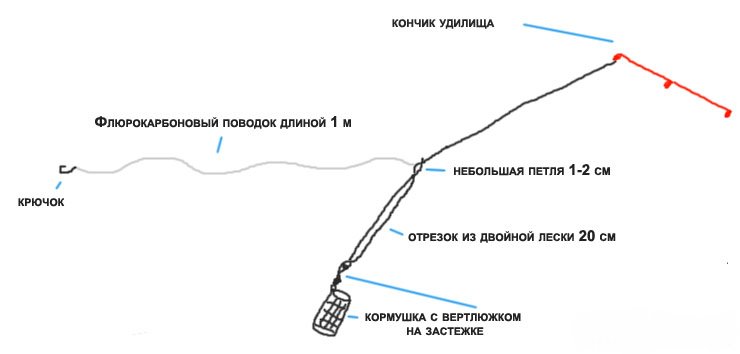
Allows you to hunt bream using light bait (a bunch of maggots). To make a helicopter you will need a rigid fishing thread with a diameter of 0.25 - 0.35 mm; fluorocarbon fishing line works well.
Manufacturing instructions:
- A fishing line with a length of 20 cm is folded in half.
- Tie a small knot , retreating 15 cm along the line folded in a figure eight.
- After 1 cm, twist another figure eight knot.
- Secure the feeder using the “loop-to-loop” method.
- To fix the leash, a throw is made between the first and subsequent knots without twisting the knot.
Symmetrical and asymmetrical loop
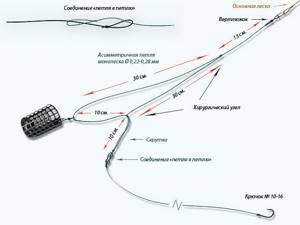
There are no significant differences in the installation principle. The differences are visible in the name, where a symmetrical loop has the same lengths of loops, and its antipode is one side shorter than the other, which has a very positive effect on the bite.
The symmetrical loop, despite its ease of assembly, is in no way inferior to the paternoster in terms of efficiency of use. The likelihood of tangling is minimal; it is more suitable for standing water. Equipment elements: main line, feeder, two swivels, leader line and hook.
Manufacturing instructions:
- The thread folded in half must be twisted with rotational movements (in one direction).
- Tie a knot 6–10 cm from the twist.
- Secure the swivel to one fishing line.
- 20 cm from the swivel .
- Twist.
- At the end of the twist, fix the swivel, and attach a leash to it, the length of which should not exceed 70 cm.
- The hook must be mounted on the leash in such a way that a large loop is formed.
- The feeder is mounted on a loop -to-loop swivel.
An asymmetrical loop is used especially effectively in reservoirs with standing water with a consistently calm bite.
Manufacturing instructions:
- A fishing thread with a length of 50 cm is folded in half.
- Using a knot, the end of such a fishing line is tied to the main thread, the main thing is to get a large circle, it is necessary for attaching the feeder.
- The hook and leash are mounted to the loop.
Paternoster
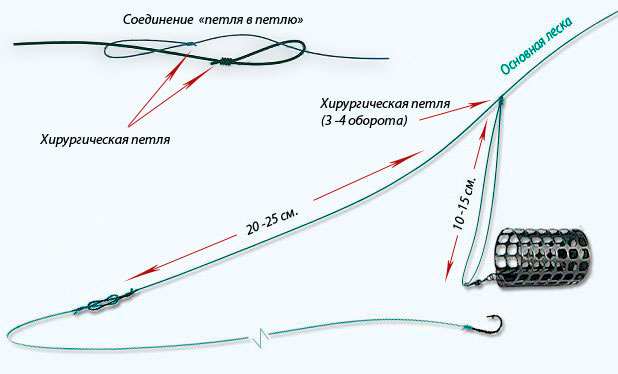
This type of equipment is especially appreciated by beginning bream fishermen; there is one drawback - the line twists. As a way out, the feeder must be lifted and untwisted. The advantage of the paternoster is its high sensitivity.
Elements of equipment: main fishing line wound on a reel, feeder, leash with hook, paternoster leash. A loop attached to the leash, a swivel for the feeder, a loop attachment point, a loop-to-loop connection for mounting the leash to the main line.
Manufacturing instructions:
- The first step is to knit a loop at the end of the main line; later a leash with a hook will be attached to it. To preserve the structure of the node, it is moistened.
- Having retreated 15 - 20 cm , another loop is knitted, the main thing is that its size allows a feeder with a diameter of 10 - 15 cm to pass through.
- The leash must be fixed on the main line ; to do this, it is threaded into the end loop, twisted and a second loop is made.
https://www.youtube.com/watch?v=b44dlz5LebE
Anchoring a boat
An anchor is a bunch of stones or cast iron blocks, weighing five to ten kilograms, depending on the wind and current.
Too little weight can affect the quality of the anchor, but too much weight will create big problems when lifting the anchor, although for strong men ten kg is not a problem, but sometimes even they can have problems.
On a soft muddy bottom, it is sometimes possible to un-anchor only by cutting the anchor ropes or pumping out the anchors due to the buoyancy of the boat. Therefore, you should not overdo it with the weight of the anchors.
Onboard fishing rod
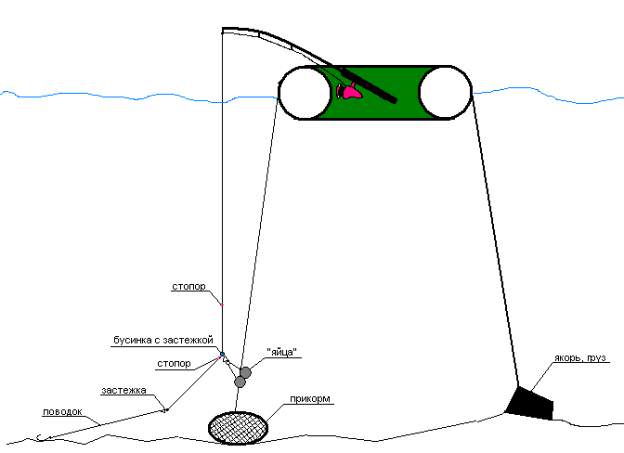
Another type of tackle for bream is a side fishing rod; it is especially indispensable when catching chebak in places of a reservoir remote from the shore. This is fishing from the side of a watercraft (an inflatable boat or a boat equipped with a motor).
Design features of the onboard fishing rod:
- A fishing tool in the form of a short rod with a length of 40–60 cm, where a nod from a winter fishing rod is used as a signaling device.
- Reliable reel model (inertia-free, inertial) with a size of 1000 – 1500.
- The main fishing line is either a monofilament thread or a braided line with a diameter of 0.15 - 0.25 mm.
- The leader material is made of monofilament with a cross-section of 0.1 – 0.15 mm and a length of 30 – 60 cm.
- Sliding type of load.
- Sharp hook from No. 6 – 14.
A promising place for fishing is determined using an echo sounder, or in the absence of one, you can navigate “by eye.” After which, the watercraft is installed in the right place, the area is fed, and the tackle is immersed in the water. In this case, you can place several rods at the same time, but on different sides.
The bite is indicated by the movement of the nod, and the hooking immediately begins (with a rod or hand on the fishing line).
Advantages and disadvantages of using side rods
Side fishing rod - Designed for vertical fishing and for this reason has modest dimensions. The material of manufacture is unimportant; fishing often takes place using a fishing line. Among the advantages it is worth highlighting:
- Price - onboard fishing rods have affordable price tags, and can also be made with your own hands without any problems
- Size - small dimensions allow you to install several of these fishing rods and at the same time fish together, they will not take up much space
Despite certain advantages, they are not without disadvantages, which include:
- Limited functionality - such a fishing rod cannot be used from the shore due to the peculiarities of its design. Maximum - embankments and marinas
- Depth - the onboard fishing rod is designed for fishing at a depth of three meters. With less, the bream simply will not be under the boat, which means casting vertically will not be particularly effective.
- Difficulties on the wave - Without the special designs described above, even a small wave can make it significantly more difficult to track the bite
The onboard fishing rod is compact and easy to carry and transport. Another undeniable advantage of such gear is that it’s easy to make an onboard fishing rod with your own hands. It will not take much time and will not require large expenses.
Usually they fish with two or three side rods at once, in which case the catches are better. Accordingly, you need to make several gears at once. Another option is to make one fishing rod as a test, test it in action, make sure everything is in order with it, and then make more.
Bottom fishing rod
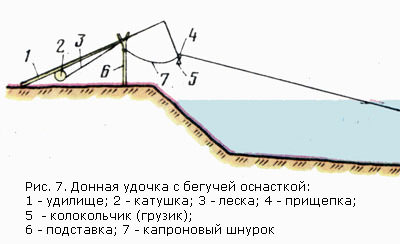
Fish feeding is especially relevant in summer and autumn. Donka is used in quiet reservoirs.
Design features of bottom gear:
- Telescopic type of fishing rod with a length of 1.5 - 2 m.
- Inertia-free reel model with a size of 2000 - 3000.
- The main line is the same as for the previous tackle.
- A load with a weight of 15 - 50 g.
- Several leashes equipped with hooks numbered 6 – 14.
- You can use a bell or an electronic model as a bite alarm
Based on numerous observations, it is effective to equip bottom tackle with a feeder (a spring for fishing in still water and a feeder feeder with a load for fishing in strong currents). The presence of a feeder makes it possible to target feeding with each subsequent cast.
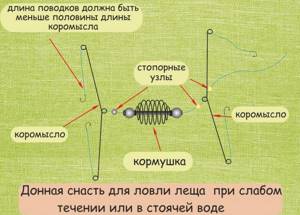
Types of bottom tackle:
- Rubber. The advantage of this design is that it simplifies the fishing process itself; there is no need to frequently throw and pull out the tackle. It is better to use elastic bands in small water areas with moderate currents.
- Makushatnik. The tackle consists of a feeder made of a lead plate, to which pieces of sunflower cake are attached, and sharp hooks are hidden in the top of the head.
- Pacifier. Here the feeder is also made of lead material, but a lid from a plastic canister or glass jar is mounted on it, into which the finished bait with hooks is placed.
- Ring. This type of donkey is made by hand from a steel ring weighing 20–50 grams and having a narrow cut. The cut, in turn, is necessary for threading the fishing thread of the feeder and for opening the main fishing line. The feeder is made of mesh, perforated plastic, its loading should be 1 - 3 kg.
- Eggs. The tackle is similar in principle and tactics to the ring, but unlike it, it consists of a large safety pin equipped with lead balls at the ends. The main line is threaded through a special hole, and the feeder line is passed between the balls. Eggs are a universal tackle; it works at any time of the year, but in open water.
Bait and groundbait
In spring, bloodworms are often used as bait. But for catching large fish, it is better not to put it on a hook, but to tie it into bundles using special devices. This way it will live longer and maintain a bright color. One or two maggot larvae are added to the bloodworm. But the all-season worm is already in use. Often, ide is very willing to take a steep decoy, to which cotton wool is added for fishing in strong currents so that the porridge stays better on the hook.
For early spring, winter bait is also used, to which bloodworms and maggots are added.
Share with your friends!
Blitz tips
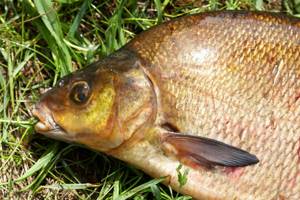
- Given the caution of the fish , it is recommended to follow the rules of camouflage when fishing.
- Tackle must be selected taking into account the expected fishing conditions , in particular whether there is a current in the reservoir or not.
- All equipment elements must be of the highest quality.
- To correctly determine the location of the bream, it is recommended to purchase a modern gadget - an echo sounder.
- The key to successful fishing is the right tackle, attractive bait and experience of the fisherman.
How to prepare everything you need for trophy bream fishing
Before going to a river or lake, you need to prepare in advance to ensure a comfortable stay on site, which will ultimately affect your catch. For experienced fishermen, this is not a problem; thanks to their experience, everything they need is loaded automatically, preventing even the slightest detail from being missed that would negatively affect fishing.
Next, we will talk about subtleties or even secrets that are useful not only for beginners, but also, perhaps, for people with experience, because it’s never too late to learn. After reading the material to the end, you will receive answers to all your questions, as well as to those that arise during reading. We will look at everything that needs to be taken into account so as not to return home without a catch, how to find the right place to fish, how to feed, and most importantly, what to collect not only bream, but also other large fish at the point.
What does a suitable boat look like?
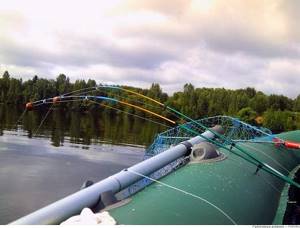
The preferred option is a fairly light flotation device. It is worth considering first of all the dimensions of the person himself; it is important that he is comfortable. A prerequisite for onboard fishing is equipment for double anchoring (in the bow and transom). Even a bunch of stones will work as an anchor. Its recommended weight is about 10 kilograms. A light load may not hold the boat in place.
Technical performance of rods
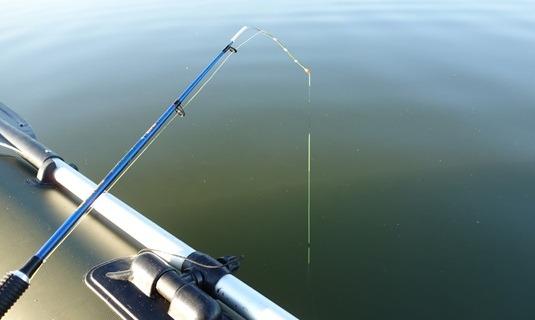
In factory versions, onboard fishing rods are practically not produced; they do not have any specific differences from others, and the choice of fishing rod comes down to ensuring that it is convenient to use on the boat. The design of the onboard fishing rod can be either cranked - telescopic or plug-in, or a solid whip, this is not of fundamental importance.
A variety of materials are used for manufacturing, but most often in factory products they use:
- carbon fiber;
- fiberglass;
- composite.
Preference is often given to fiberglass telescopic rods, as they are less expensive. But carbon fiber ones are more sensitive. And in calm weather, you don’t even need to install a side nod for a summer fishing rod. The tip of the spinning rod will notify you of a bite.
The optimal length is considered to be 0.8-1.0 m. But this is not a dogma: any winter donka is quite suitable for summer fishing from a boat. A guard for a bottom fishing rod will warn the angler about a bite no worse than the same float or feeder of a spinning rod. By the way, short spinning rods are successfully used not only on the shore, but also when fishing from a boat, and equipping it is possible in all types of coastal fishing.
Fishing from a watercraft, as a rule, does not require long casts, and therefore expensive and complex in design spinning reels are not used here. You can also place the fishing line on a reel, but simple inertial reels are used.
Every fisherman knows how to make a fishing rod on his own for winter fishing, and an onboard fishing rod can be made in a similar way. There is nothing complicated here: the barrel is selected from old parts, for example, it could be the tip of a spinning rod. The handle can be made from cork material from bottles, making holes in them and placing them on glue. You can buy an inexpensive coil and secure it to the barrel with electrical tape, wire, or glue. The nod for an onboard fishing rod is selected according to the fishing conditions: for a large predator in deep water, a hard long nod is needed, and vice versa, in shallow water for catching small fish, a sensitive alarm that can recognize a careful bite is more suitable. Well suited for the role of a bite indicator for bottom fishing rods. Regarding the fishing line, choose it in the usual manner, but it should be taken into account that with a rigid quivertype (hook indicator), the slack of the fishing line is selected. However, due to the small bend it will be difficult to see. If the quivertype is soft, it will bend well, but will not pick up the slack.
Therefore, it is preferable for small fish to put a guard on the rod for bottom fishing. For large prey, a spinning feeder is suitable.


